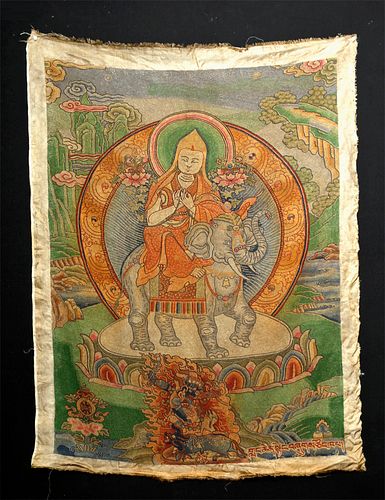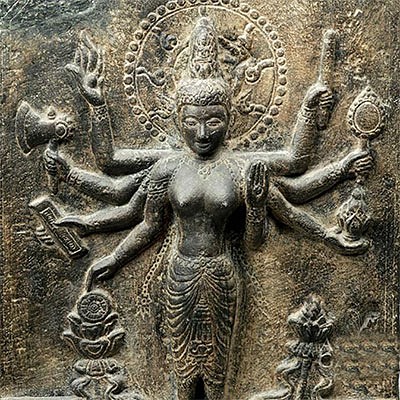19th C. Tibetan Dazi Silk Thangka - Tsongkhapa
Lot 24
About Seller
Artemis Fine Arts
686 S Taylor Ave, Ste 106
Louisville, CO 80027
United States
Selling antiquities, ancient and ethnographic art online since 1993, Artemis Gallery specializes in Classical Antiquities (Egyptian, Greek, Roman, Near Eastern), Asian, Pre-Columbian, African / Tribal / Oceanographic art. Our extensive inventory includes pottery, stone, metal, wood, glass and textil...Read more
Estimate:
$2,000 - $3,000
Absentee vs Live bid
Two ways to bid:
- Leave a max absentee bid and the platform will bid on your behalf up to your maximum bid during the live auction.
- Bid live during the auction and your bids will be submitted real-time to the auctioneer.
Bid Increments
| Price | Bid Increment |
|---|---|
| $0 | $25 |
| $300 | $50 |
| $1,000 | $100 |
| $2,000 | $250 |
| $5,000 | $500 |
| $10,000 | $1,000 |
| $20,000 | $2,500 |
| $50,000 | $5,000 |
| $100,000 | $10,000 |
| $200,000 | $20,000 |
About Auction
By Artemis Fine Arts
Feb 4, 2021
Set Reminder
2021-02-04 10:00:00
2021-02-04 10:00:00
America/New_York
Bidsquare
Bidsquare : CLEARANCE Asian | Antiquities | Ethnographic
https://www.bidsquare.com/auctions/artemis-gallery/clearance-asian-antiquities-ethnographic-6361
Featuring discounted pricing on Asian art, classical antiquities from Egypt, Greece, Italy, and the Near East...plus Pre-Columbian, Tribal, Russian Icons, Spanish Colonial, Fine Art, more! Starting prices have been reduced up to 65% from original auction prices - perfect for dealers and collectors! Artemis Fine Arts info@artemisgallery.com
Featuring discounted pricing on Asian art, classical antiquities from Egypt, Greece, Italy, and the Near East...plus Pre-Columbian, Tribal, Russian Icons, Spanish Colonial, Fine Art, more! Starting prices have been reduced up to 65% from original auction prices - perfect for dealers and collectors! Artemis Fine Arts info@artemisgallery.com
- Lot Description
**Originally Listed At $4000**
Tibet, ca. late 19th to early 20th c. CE. An embroidered silk thangka painstakingly created with a very fine "Dazi" stitch (also called "Forbidden Stitch" or "Blind Stitch") depicting Tsongkhapa (also Je Tsongkappa ), a major religious reformer of Tibetan Buddhism, here portrayed riding an elephant on a lotus base, surrounded by a picturesque landscape, clouds, and flowing waters. Below are the Wrathful Yama and his consort and twin sister Yami; the Wheel of the Law upon a lotus blossom on the lower left, Tibetan script that translated to, "Tsongka riding on elephant" on the lower right, and an orb-shaped sun and moon near the upper corners. A breathtaking composition mounted on a golden silk mat, replete with rich iconography, stunning design, a brilliant graduated color palette, and a rare masterful command of the refined Dazi Stitch. Size: 34.125" L x 25.25" W (86.7 cm x 64.1 cm); 37.75" L x 28.75" W (95.9 cm x 73 cm) including border
Tsongkhapa (also Je Tsongkhapa or man from Tsongkha, 1357-1419) sometimes referred to as "the Man from Onion Valley" was a very famous teacher of Tibetan Buddhism whose teachings and actions led to the founding of the Gelug school of Tibetan Buddhism. He is also sometimes known by his ordained name: Losang Drakpa or "Je Rinpoche."
The Dazi (Forbidden Stitch or Blind Stitch) refers to the knotted stitches used in conjunction with satin stitches that were reserved for the most exquisite, finely crafted silk costumes, robes, and rank badges. One romantic legend offers that the alternative term Blind Stitch arose because embroidering with this stitch gave young girls eye strain due to its fineness and intricacy. Whether called the Dazi stitch, the Forbidden Stitch, or the Blind Stitch, these all involve making small knots on the fabric surface by wrapping a heavy embroidery thread, typically silk floss, around a needle and then stitching it down. Embroiderers have done this with varying numbers of wrappings and a wide range of complexity. According to expert Wang Yarong, more than twenty varieties of knot stitch can be found throughout history, in East Asia alone. Apparently, early relics of this stitch have been found in an Eastern Han tomb at Nuoyinwula, Outer Mongolia, and even earlier examples on a pair of silk shoes were discovered in a tomb of the Warring States period in the Linzi, Shandong Province.
Provenance: private Bricker collection, Charlottesville, Virginia, USA
All items legal to buy/sell under U.S. Statute covering cultural patrimony Code 2600, CHAPTER 14, and are guaranteed to be as described or your money back.
A Certificate of Authenticity will accompany all winning bids.
We ship worldwide and handle all shipping in-house for your convenience.
#124144Silk border shows slight discoloration/staining, expected fraying, and minor losses. Embroidered composition is overall excellent.Condition
- Shipping Info
-
All shipping is handled in-house for your convenience. Your invoice from Artemis Gallery will include shipping calculation instructions. If in doubt, please inquire BEFORE bidding for estimated shipping costs for individual items.
-
- Buyer's Premium



 EUR
EUR CAD
CAD AUD
AUD GBP
GBP MXN
MXN HKD
HKD CNY
CNY MYR
MYR SEK
SEK SGD
SGD CHF
CHF THB
THB







